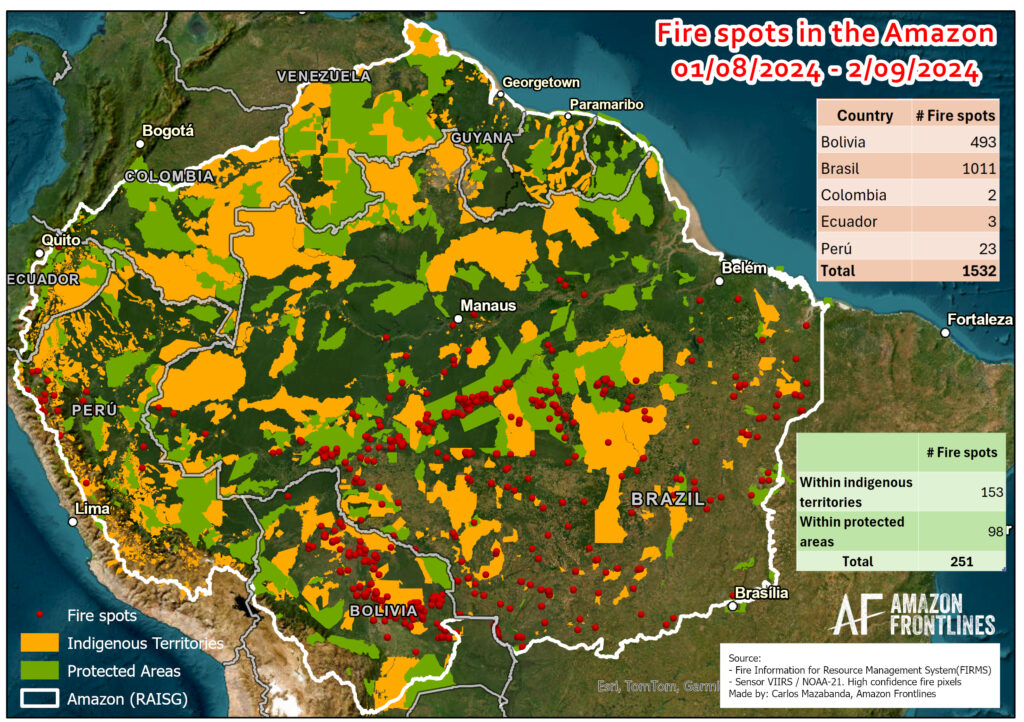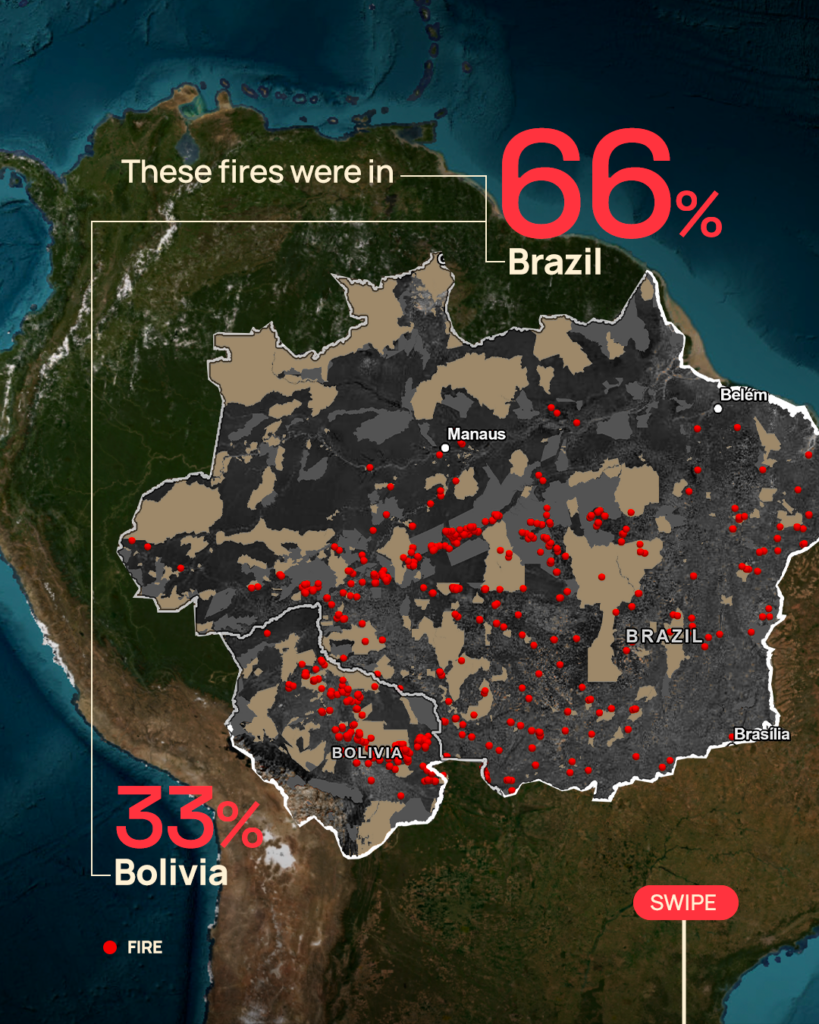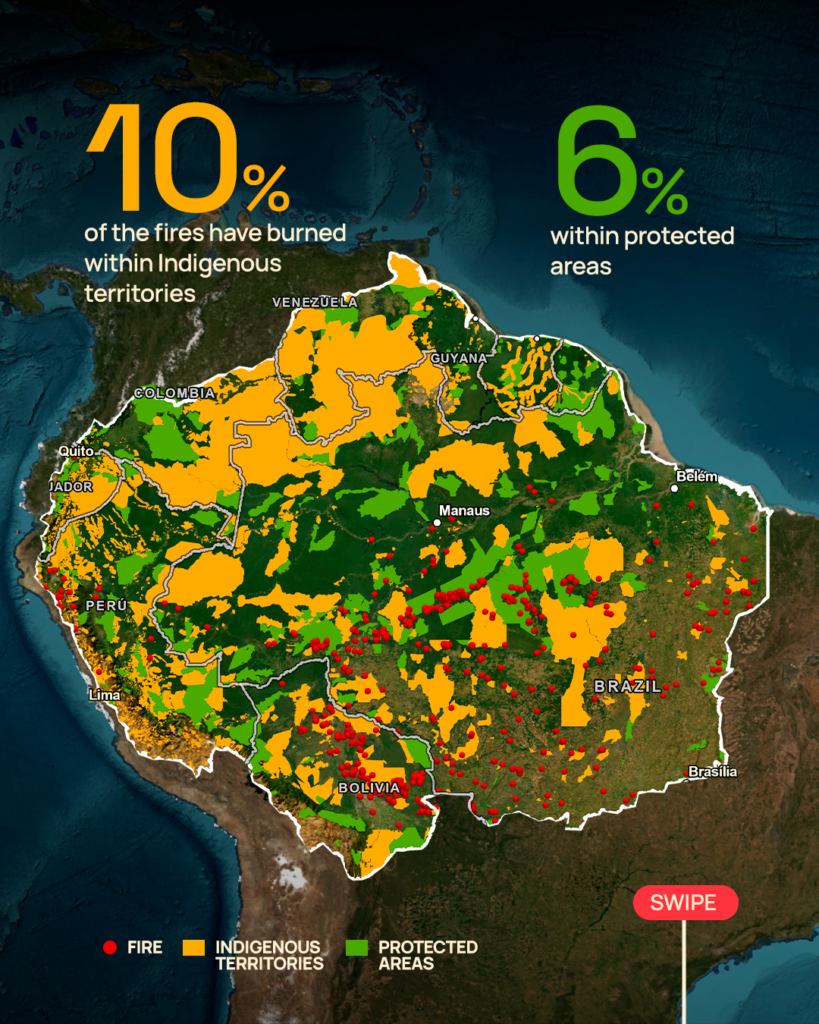With Information from Carlos Mazabanda
According to research by Carlos Mazabanda, Monitoring and Mapping Coordinator for Amazon Frontlines, the Amazon rainforest was ravaged by 1,532 wildfires between August 1 and September 2, 2024. The fires, tracked by the Fire Information for Resource Management System (FIRMS), reveal a disturbing trend across the region. Brazil and Bolivia account for 98% of the wildfires, with Brazil alone seeing 66% of the fires and Bolivia responsible for 32%.
Mazabanda’s analysis sheds light on the broader ecological and human impact, showing that the fires are burning through vast areas of natural vegetation and infringing on protected territories. These figures reveal the scale of the ongoing crisis.

Natural Vegetation Destroyed in Brazil
While fires in the Amazon are often linked to agricultural activities such as cattle ranching and farming, recent data shows a different reality. Of the fires recorded, according to MapBiomas, in Brasil from 2022, 73% of the fires ignited in areas with natural vegetation, not farmland. Only 21% were located in areas corresponding to agricultural purposes, emphasizing that the flames are ravaging untouched ecosystems, which play a critical role in regulating the climate and sustaining biodiversity.
This is a significant shift, signaling that wildfires are not confined to regions already altered by human activity. Instead, they are striking at the heart of the Amazon's untouched wilderness, where ecosystems are particularly vulnerable to destruction.

Impact on Indigenous Territories and Protected Areas in the Amazon
Equally troubling is the encroachment of these fires into Indigenous territories and protected areas. According to the analysis by Carlos Mazabanda from Amazon Frontlines, 10% of the fires—a total of 251—have occurred within Indigenous lands, while 6% have spread into protected areas.
In practical terms, this means that 15 protected areas and 35 Indigenous territories have been directly impacted. Brazil, the most prominent host of these protected regions, saw 14 protected areas damaged by fire, while Ecuador reported fire activity in one protected zone. In terms of Indigenous territories, the destruction spanned 13 regions in Bolivia, 20 in Brazil, and 2 in Peru, threatening the homes, cultures, and livelihoods of countless Indigenous communities who rely on the forest for survival.

A Human and Ecological Crisis
This surge in wildfires marks more than an environmental catastrophe. It is an existential threat to Indigenous communities and the delicate ecosystems they protect. Indigenous peoples in these regions are more than just stewards of the land; they embody centuries of knowledge about living in harmony with nature. Their territories are now facing unprecedented devastation.
Protected areas, established to safeguard biodiversity, are also under siege. Once considered sanctuaries, these zones are now falling victim to flames that are increasingly difficult to control as fire seasons grow longer and more intense.
The 2024 fires are a chilling reminder of the Amazon's vulnerability—not only to direct human actions like deforestation but also to the indirect consequences of climate change and weakened environmental protections. As temperatures rise and dry seasons extend, the likelihood of future wildfires becomes a growing threat.

Looking Ahead
As the Amazon burns, the world watches. The 2024 fires provide a stark warning that the natural and human crises in the Amazon are deeply intertwined. The destruction is not confined to faraway, rural areas—it impacts a global ecosystem essential for climate regulation and the well-being of future generations.
This year’s fire season reveals a need for urgent attention, both in the regions affected and in international discourse. The Amazon, often called the “lungs of the Earth,” is choking under the weight of this ongoing crisis, with no signs of relief in sight.




